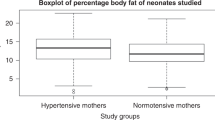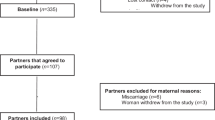Abstract
Background:
Undernutrition in neonates increases the risk of serious morbidities. The objective of this study was to describe neonatal morbidity associated with low body fat percentage (BF%) and measure the number of undernourished neonates defined by BF% and compare this with birth weight percentiles (<10th).
Methods:
Eligibility included term (≥37 wk) neonates. BF% measurements were undertaken by air displacement plethysmography. Data on neonatal outcomes were extracted from medical records and used to develop a measure of neonatal morbidity. We assessed the association between neonatal morbidity and population-based birth weight percentiles compared with the BF% measurements.
Results:
Five hundred and eighty-one neonates were included. Low BF% was defined by 1 SD below the mean and identified in 73 per 1,000 live births. Neonatal morbidity was found in 3.4% of neonates. Birth weight percentile was associated with neonatal morbidity (odds ratio (OR): 1.03 (95% confidence interval (CI): 1.01, 1.05); P = <0.001). BF% was associated with a higher risk of neonatal morbidity (OR: 1.30 (95% CI: 1.15, 1.47); P = <0.001).
Conclusion:
In this population, measuring BF% is more closely associated with identification of neonates at risk of neonatal morbidity as compared with birth weight percentiles. BF% measurements could assist with identifying neonates who are appropriately grown yet undernourished and exclude small neonates not at risk.
Similar content being viewed by others
Log in or create a free account to read this content
Gain free access to this article, as well as selected content from this journal and more on nature.com
or
References
Adebami OJ, Owa JA . Comparison between CANSCORE and other anthropometric indicators in fetal malnutrition. Indian J Pediatr 2008;75:439–42.
Lawn JE, Cousens S, Zupan J ; Lancet Neonatal Survival Steering Team. 4 million neonatal deaths: when? Where? Why? Lancet 2005;365:891–900.
Bryce J, Boschi-Pinto C, Shibuya K, Black RE ; WHO Child Health Epidemiology Reference Group. WHO estimates of the causes of death in children. Lancet 2005;365:1147–52.
Grantham-McGregor SM, Walker SP, Chang S . Nutritional deficiencies and later behavioural development. Proc Nutr Soc 2000;59:47–54.
Barker DJ, Eriksson JG, Forsén T, Osmond C . Fetal origins of adult disease: strength of effects and biological basis. Int J Epidemiol 2002;31:1235–9.
Wells JC, Chomtho S, Fewtrell MS . Programming of body composition by early growth and nutrition. Proc Nutr Soc 2007;66:423–34.
Salihoglu O, Karatekin G, Ilhan R, Nuhoglu A . Placental findings in malnourished term neonates. Pediatr Int 2009;51:494–7.
Sankhyan N, Sharma VK, Singh S . Detection of fetal malnutrition using “CAN score”. Indian J Pediatr 2009;76:903–6.
Gustafsson J . Neonatal energy substrate production. Indian J Med Res 2009;130:618–23.
Cowett RM, Loughead JL . Neonatal glucose metabolism: differential diagnoses, evaluation, and treatment of hypoglycemia. Neonatal Netw 2002;21:9–19.
Rigo J . Body composition during the first year of life. Nestle Nutr Workshop Ser Pediatr Program 2006;58:65–76; discussion 76–8.
Deierlein AL, Thornton J, Hull H, Paley C, Gallagher D . An anthropometric model to estimate neonatal fat mass using air displacement plethysmography. Nutr Metab (Lond) 2012;9:21.
Carberry AE, Colditz PB, Lingwood BE . Body composition from birth to 4.5 months in infants born to non-obese women. Pediatr Res 2010;68:84–8.
Ellis KJ, Yao M, Shypailo RJ, Urlando A, Wong WW, Heird WC . Body-composition assessment in infancy: air-displacement plethysmography compared with a reference 4-compartment model. Am J Clin Nutr 2007;85:90–5.
Ma G, Yao M, Liu Y, et al. Validation of a new pediatric air-displacement plethysmograph for assessing body composition in infants. Am J Clin Nutr 2004;79:653–60.
Sainz RD, Urlando A . Evaluation of a new pediatric air-displacement plethysmograph for body-composition assessment by means of chemical analysis of bovine tissue phantoms. Am J Clin Nutr 2003;77:364–70.
Urlando A, Dempster P, Aitkens S . A new air displacement plethysmograph for the measurement of body composition in infants. Pediatr Res 2003;53:486–92.
Yao M, Nommsen-Rivers L, Dewey K, Urlando A . Preliminary evaluation of a new pediatric air displacement plethysmograph for body composition assessment in infants. Acta Diabetol 2003;40 Suppl 1:S55–8.
Andersen GS, Girma T, Wells JC, Kæstel P, Michaelsen KF, Friis H . Fat and fat-free mass at birth: air displacement plethysmography measurements on 350 Ethiopian newborns. Pediatr Res 2011;70:501–6.
Fields DA, Gilchrist JM, Catalano PM, Giannì ML, Roggero PM, Mosca F . Longitudinal body composition data in exclusively breast-fed infants: a multicenter study. Obesity (Silver Spring) 2011;19:1887–91.
Lingwood BE, Storm van Leeuwen AM, Carberry AE, et al. Prediction of fat-free mass and percentage of body fat in neonates using bioelectrical impedance analysis and anthropometric measures: validation against the PEA POD. Br J Nutr 2012;107:1545–52.
Grund B, Sabin C . Analysis of biomarker data: logs, odds ratios, and receiver operating characteristic curves. Curr Opin HIV AIDS 2010;5:473–9.
Kramer MS, Olivier M, McLean FH, Willis DM, Usher RH . Impact of intrauterine growth retardation and body proportionality on fetal and neonatal outcome. Pediatrics 1990;86:707–13.
Clausson B, Gardosi J, Francis A, Cnattingius S . Perinatal outcome in SGA births defined by customised versus population-based birthweight standards. BJOG 2001;108:830–4.
de Jong CL, Gardosi J, Dekker GA, Colenbrander GJ, van Geijn HP . Application of a customised birthweight standard in the assessment of perinatal outcome in a high risk population. Br J Obstet Gynaecol 1998;105:531–5.
Pallotto EK, Kilbride HW . Perinatal outcome and later implications of intrauterine growth restriction. Clin Obstet Gynecol 2006;49:257–69.
Gilbert WM, Danielsen B . Pregnancy outcomes associated with intrauterine growth restriction. Am J Obstet Gynecol 2003;188:1596–9; discussion 1599–601.
Rogers IS, Emmett PM, Golding J . The incidence and duration of breast feeding. Early Hum Dev 1997;49 Suppl:S45–74.
Scott JA, Landers MC, Hughes RM, Binns CW . Factors associated with breastfeeding at discharge and duration of breastfeeding. J Paediatr Child Health 2001;37:254–61.
Walther FJ, Ramaekers LH . The ponderal index as a measure of the nutritional status at birth and its relation to some aspects of neonatal morbidity. J Perinat Med 1982;10:42–7.
Naylor AJ . Baby-Friendly Hospital Initiative. Protecting, promoting, and supporting breastfeeding in the twenty-first century. Pediatr Clin North Am 2001;48:475–83.
Korkmaz A, Teksam O, Yurdakök M, Yigit S, Tekinalp G . Fetal malnutrition and its impacts on neonatal outcome in preterm infants. Turk J Pediatr 2011;53:261–8.
Roggero P, Giannì ML, Orsi A, et al. Neonatal period: body composition changes in breast-fed full-term newborns. Neonatology 2010;97:139–43.
Beeby PJ, Bhutap T, Taylor LK . New South Wales population-based birthweight percentile charts. J Paediatr Child Health 1996;32:512–8.
Fomon SJ, Haschke F, Ziegler EE, Nelson SE . Body composition of reference children from birth to age 10 years. Am J Clin Nutr 1982;35(5 Suppl):1169–75.
Wood AJ, Raynes-Greenow CH, Carberry AE, Jeffery HE . Neonatal length inaccuracies in clinical practice and related percentile discrepancies detected by a simple length-board. J Paediatr Child Health 2013;49:199–203.
Jeffery HE, Henderson-Smart DJ, Hill DA . Competency-based learning in neonatology. Med Educ 1996;30:440–4.
DeLong ER, DeLong DM, Clarke-Pearson DL . Comparing the areas under two or more correlated receiver operating characteristic curves: a nonparametric approach. Biometrics 1988;44:837–45.
Acknowledgements
The PEA POD donors included TENIX (Sydney, Australia) and an anonymous donor to the University of Sydney. The authors thank Royal Prince Alfred Hospital medical and nursing staff and Lucia Wang, Cheryl Au, Elizabeth Hayles, and Erin Donnelley for assisting with data collection. We thank the parents for their assistance in this project.
Author information
Authors and Affiliations
Corresponding author
Rights and permissions
About this article
Cite this article
Carberry, A., Raynes-Greenow, C., Turner, R. et al. Is body fat percentage a better measure of undernutrition in newborns than birth weight percentiles?. Pediatr Res 74, 730–736 (2013). https://doi.org/10.1038/pr.2013.156
Received:
Accepted:
Published:
Issue date:
DOI: https://doi.org/10.1038/pr.2013.156
This article is cited by
-
Reduced adipose tissue in growth-restricted fetuses using quantitative analysis of magnetic resonance images
European Radiology (2023)
-
A hospital-based cohort study of gender and gestational age-specific body fat percentage at birth
Pediatric Research (2021)
-
Reliability of routine anthropometric measurements to estimate body composition in term infants
Pediatric Research (2021)
-
Reduced growth velocity from the mid-trimester is associated with placental insufficiency in fetuses born at a normal birthweight
BMC Medicine (2020)
-
Anthropometric and clinical correlates of fat mass in healthy term infants at 6 months of age
BMC Pediatrics (2019)



